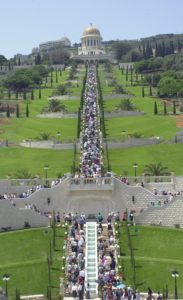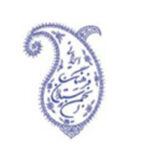Marking measures of time
The following article, originally published in the Fall 2019 issue of Bahá’í Canada, offers a look back at the first century of the Formative Age and provides additional context to the historic announcement in the Ridvan 2021 message from the Universal House of Justice: “With elated hearts, we announce that the third epoch of the Master’s Divine Plan has begun.”

Design of the Shrine of ‘Abdu’l-Baha, nighttime bird’s-eye view. Photo: Bahá’í International Community
On 28 November 2021, the Bahá’í community will commemorate the centenary of the Ascension of ‘Abdu’l-Bahá. His passing marked the end of the 77 years of the Heroic Age of our Faith, the opening of the Formative Age and the birth of the Administrative Order. This approaching centenary is an occasion for us as a community to reflect on who we are, where we have come from, and to offer insights into the multiple processes of learning initiated by the Master that we are currently engaged in.
This article offers an overview and a list of resources the reader can consult to explore these early stages of a “vast evolutionary process of development that will, in time, lead to a transformation in all aspects of the life of the Bahá’í community and the functioning of its institutions.”[i]
When the Formative Age commenced, an increasingly globalized world was still recovering from a devastating world war, greater than any waged before: over 65 million troops were mobilized, over 21 million were wounded[ii] and over 15 million died[iii] in a struggle which sharply altered the political, economic, social and cultural nature of Europe. At that time, the National Fascist Party was taking root in Italy; Albert Einstein was awarded the Nobel Prize in Physics for his work with the photoelectric effect; researchers at the University of Toronto had just discovered the hormone insulin; and Agnes Macphail became the first woman to be elected to the Canadian Parliament.
Against that backdrop, Shoghi Effendi had inherited a community of a few hundred centres in 35 countries. Some events of interest within the small Bahá’í world community in 1921 included: the birth in Portuguese Guinea of Eduardo Duarte Vieira, who was to become the first African Bahá’í martyr; the beginning of construction on the House of Worship in Wilmette, Illinois; Agnes Alexander’s trip to Korea to share the Bahá’í teachings; and the enrolment into the Faith of Canadian Siegfried Schopflocher, who would be appointed a Hand of the Cause of God.
Epochs of the Formative Age during Shoghi Effendi’s Ministry
Among the many things the Guardian did to strengthen the identity and vision of the community was to mark measures of time. One of the ways he did this was by designating epochs to the Formative Age, the time in which we currently live. Shoghi Effendi’s ministry saw the first two epochs of the Formative Age, while the Universal House of Justice has so far designated three epochs, the fifth of which we are currently in. An epoch has so far lasted for about 18 years, somewhat akin to the period that separates generations.
The transition from one epoch to another may not be abrupt, nor is it strictly associated with a single event. It seems, rather, to represent stages in an organic process, in which the identity of our world community may not look much different from the end of one epoch to the start of another. Instead, taking a longer view, there are clear signs of collective maturation from one point in time to another. Even in the case of the inception of the Formative Age itself, the passing of ‘Abdu’l-Bahá was indeed the transitional event marking the close of the Heroic Age, but the Guardian also noted that it concluded “more particularly with the passing [in 1932] of His well- beloved and illustrious sister, the Most Exalted Leaf—the last survivor of a glorious and heroic age.”[iv]
Moreover, the first epoch of the Formative Age did not terminate on a single year, but rather during the period of 1944 to 1946 – two years that separated the first two Seven Year Plans initiated by the Guardian for the American Bahá’í community, which, until the establishment of the National Spiritual Assembly of the Bahá’ís of Canada in 1948, also included the Canadian Bahá’í community. This epoch was the period in which the framework of the Administrative Order of the Faith was laid out, with the building of local and national institutions in all the five continents of the world.
For students of Shoghi Effendi’s writings, it may be of interest that his major writings were released during the first epoch: the “World Order” letters,[v] The Advent of Divine Justice, The Promised Day is Come, as well as his seminal book, God Passes By. To chronologically follow the guidance given by the Guardian to the American community as they were building their institutions during the first epoch, two books contain a compilation of his letters to the North American Bahá’í community during this period: Bahá’í Administration and This Decisive Hour.
The second epoch lasted until the election of the Universal House of Justice in 1963. This epoch saw the further consolidation of the Administrative Order, with national plans being prosecuted by different national communities to propagate and consolidate the Cause throughout the world. It culminated in the Ten Year World Crusade with 12 national plans that took their direction from ‘Abdu’l-Bahá’s Divine Plan, with the goals assigned by Shoghi Effendi from the World Centre of the Faith.
This epoch also saw the rise and consolidation of the World Centre of the Faith. During this time, the Guardian appointed Hands of the Cause, introduced the institution of the Auxiliary Board, and established the International Bahá’í Council. At the close of the epoch, the Universal House of Justice was elected. The book Citadel of Faith contains a collection of messages from Shoghi Effendi to the Bahá’ís of the United States, written between 1947 and 1957, to give insight into how the Faith was evolving during this period. The Ministry of the Custodians is another valuable resource that helps us understand how the Hands of the Cause of God guided the Bahá’í world community between the passing of Shoghi Effendi in 1957 and the election of the Universal House of Justice in 1963.
Epochs of the Formative Age under the Universal House of Justice
The Guardian foresaw that, in succeeding epochs of the Formative Age, the Universal House of Justice would launch a series of worldwide enterprises which would “symbolize the unity and coordinate and unify the activities” of National Spiritual Assemblies.[vi]
The third epoch – and the first one under the House of Justice – lasted from 1963 until 1986 and contained three world plans derived largely from the World Centre: the Nine Year Plan (1964–1973), the Five Year Plan (1974–1979) and the Seven Year Plan (1979–1986). It was a period that saw the emergence of the Faith from obscurity, not least due to the persecutions of the community in Iran following the revolution in that country. It was also a time in which initial steps were taken to foster the social and economic development of communities, the institution of the Continental Boards of Counsellors was created and the International Teaching Centre was established. The book Messages from the Universal House of Justice 1963-1986 compiles all the major messages released during this period.

Bahá’ís stream up the central staircase of the terraces of the Shrine of the Báb on Mount Carmel during an inaugural ceremony on 23 May 2001. Photo: Bahá’í International Community.
The fourth epoch concluded in 2001 and introduced a change in the way national plans were formulated. Specific goals for each national community were now to be devised within the framework of the overall objectives of the Plan, by means of consultation between the particular National Spiritual Assembly and the Continental Board of Counsellors. The advancement of the institution of the Counsellors was indeed a hallmark of this period, and the Universal House of Justice noted that it had “reached a new stage in its maturation.”[vii] Other signal developments included a change in the very “culture of the Bahá’í community as training institutes emerged, as the construction projects on Mount Carmel approached their completion, and as the internal processes of institutional consolidation and the external processes towards world unity became more fully synchronized.”[viii] The book Messages from the Universal House of Justice 1986-2001 contains all the major messages released during this period.
The commentary Century of Light is another source to consult to understand the reality of the Bahá’í world community at the end of the fourth epoch. In encouraging its study, the House of Justice stated that it would “prove both spiritually enriching and of practical help in sharing with others the challenging implications of the Revelation brought by Bahá’u’lláh.”[ix] In particular, it is instructive to observe the ways in which the launch of the Four Year Plan in 1996 set in motion the series of global plans in which our community is currently operating, with the centrality of the training institute in raising the capacity of individuals, communities and institutions to advance the process of entry by troops.
The Fifth Epoch: The time in which we live
At the beginning of the fifth epoch, the Universal House of Justice stated that the Bahá’í world community had reached “a new state of mind” and “a moment of consciousness,” followed by the remarkable statement that it was “deeply grateful to the Blessed Beauty to be able to recognize and acclaim” this level of consciousness. The elements defining this new stage were “a heightened awareness of the value of process, the necessity of planning and the virtue of systematic action in fostering growth and in developing the human resources.”[x] The worldwide community, had, in a sense, collectively become more insightful, methodical and wise.
Building on this strength, a life of worship and service has increasingly come to embody what Bahá’ís “do” and seek to initiate in the communities in which they live. The House of Justice accordingly noted in 2001 that “a feature of the Fifth Epoch will be the enrichment of the devotional life of the community through the raising up of national Houses of Worship.”[xi] In 2012 it announced that national Mashriqu’l- Adhkár s were to be raised up in the Democratic Republic of the Congo and Papua New Guinea, and added the first local Houses of Worship in each of the following clusters: Battambang, Cambodia; Bihar Sharif, India; Matunda Soy, Kenya; Norte del Cauca, Colombia; and Tanna, Vanuatu. These were places “where the process of entry by troops was sufficiently well advanced,” and “the response of their peoples to the possibilities created by the current series of Plans has been nothing short of remarkable,” and where “the correlation of worship and service is especially pronounced.”[xii]
Associated with the collective raising of consciousness is what the House of Justice marked as a change in the culture of the community. It is perhaps by reflecting on this aspect of culture that we can best understand who we are as a community and the processes of learning we are engaged in. Below is a brief compilation of some references that speak to some of the elements of culture to which the House of Justice has spoken to in its messages during the current epoch:
- “It is heartening, indeed, to see the culture of learning that is taking root everywhere, as the Bahá’í world community focuses on advancing the process of entry by troops.”[xiii]
- “Let them not fail to appreciate the value of the culture now taken root in the community that promotes the systematic study of the Creative Word in small groups in order to build capacity for service.”[xiv]
- “We feel moved, as we take pause on this festive occasion, to make clear that what evokes such a deep sense of pride and gratitude in our hearts is not so much the numerical feat you have achieved, remarkable as it is, but a combination of developments at the more profound level of culture, to which this accomplishment attests.”[xv]
- “To meet this challenge, the believers and the institutions that serve them will have to strengthen the institute process in the cluster, increasing significantly within its borders the number of those capable of acting as tutors of study circles; for it should be recognized that the opportunity now open to the friends to foster a vibrant community life in neighbourhoods and villages, characterized by such a keen sense of purpose, was only made possible by crucial developments that occurred over the past decade in that aspect of Bahá’í culture which pertains to deepening.”[xvi]
- “That the Bahá’í world has succeeded in developing a culture which promotes a way of thinking, studying, and acting, in which all consider themselves as treading a common path of service – supporting one another and advancing together, respectful of the knowledge that each one possesses at any given moment and avoiding the tendency to divide the believers into categories such as deepened and uninformed – is an accomplishment of enormous proportions.”[xvii]
- “It signals the significant strengthening of a culture in which learning is the mode of operation, a mode that fosters the informed participation of more and more people in a united effort to apply Bahá’u’lláh’s teachings to the construction of a divine civilization, which the Guardian states is the primary mission of the Faith.”[xviii]
- “In relationships among the friends, then, this development in culture finds expression in the quality of their interactions.”[xix]
- “Not only does this advance in culture influence relations among individuals, but its effects can also be felt in the conduct of the administrative affairs of the Faith.”[xx]
- “Finally, a significant advance in culture, one which we have followed with particular interest, is marked by the rise in capacity to think in terms of process.”[xxi]
- “In short, the community-building work in which the friends are engaged influences aspects of culture.”[xxii]
- “As a prime example, the advances at the level of culture being witnessed in some villages and neighbourhoods are due in no small part to what is being learned from Bahá’í involvement in social action.”[xxiii]
- “We are gratified to see how a culture of mutual support, founded on fellowship and humble service, has quite naturally established itself in such quarters, enabling more and more souls to be systematically brought within the pale of the community’s ”[xxiv]
- “Qualities of mutual support, reciprocity, and service to one another begin to stand out as features of an emerging, vibrant culture among those involved in activities.”[xxv]
- “Participation in these foundational activities is becoming so embedded in the culture of the population that it is viewed as an indispensable aspect of the life of a community.”[xxvi]
Key resources to read more about developments during this epoch are: Turning Point – Selected Messages of the Universal House of Justice and Supplementary Material 1996–2006 and Framework for Action – Selected Messages of the Universal House of Justice and Supplementary Material 2006–2016.
Significant messages to highlight since the publication of the latter volume above include:
- 1 March 2007 – Regarding economic life
- Ridván Message 2017
- 27 April 2017 – Regarding engaging in social action and public discourse, and non- involvement in political affairs
- October 2017 – Marking the bicentenary of the Birth of Bahá’u’lláh
- 31 October 2017 – Following the bicentenary of the Birth of Bahá’u’lláh
- 29 November 2017 – Regarding climate change
- 27 December 2017 – Regarding religious prejudice
- Ridván Message 2018
- 9 November 2018 – Regarding the establishment of the Bahá’í International Development Organization
- 26 November 2018 – On the occasion of the Day of the Covenant and the commemoration of the passing of ‘Abdu’l-Bahá
- 18 January 2019 – Message on world peace
- Ridván Message 2019
- October 2019 – Marking the bicentenary of the Birth of the Báb[xxvii]
In addition to these messages, it might be helpful to refer to the second and third unit of Ruhi Book 8: The Covenant of Bahá’u’lláh, as well as the second unit of Book 9: Gaining an Historical Perspective.
– Vahid Spencer
[i] Written on behalf of the Universal House of Justice to an individual, 30 September 2008.
[ii] From Encyclopedia Britannica Online, “World War I: 1914-1918”.
[iii] International Encyclopedia of the First World War, 1914-1918 online.
[iv] Shoghi Effendi, The World Order of Bahá’u’lláh, p. 98.
[v] Seven letters written by Shoghi Effendi and addressed to the Bahá’ís of the United States and the West, first collected in 1938, and compiled in the book entitled The World Order of Bahá’u’lláh.
[vi] From the Universal House of Justice to the Bahá’ís of the World acting under the Mandate of ‘Abdu’l-Bahá, 26 March 2016.
[vii] From the Universal House of Justice to the Bahá’ís of the World, 16 January 2001.
[viii] Ibid.
[ix] From the Foreword of Century of Light.
[x] From the Universal House of Justice to the Bahá’ís of the World, Ridván 2001.
[xi] Ibid.
[xii] From the Universal House of Justice to the Bahá’ís of the World, Ridván 2012.
[xiii] From the Universal House of Justice to the Bahá’ís of the World, 17 January 2003.
[xiv] From the Universal House of Justice to the Bahá’ís of the World, 20 October 2008.
[xv] From the Universal House of Justice to the Bahá’ís of the World, Ridván 2010.
[xvi] Ibid.
[xvii] Ibid.
[xviii] Ibid.
[xix] Ibid.
[xx] Ibid.
[xxi] From the Universal House of Justice to the Conferences of the Continental Boards of Counsellors, 28 December 2010.
[xxii] From the Universal House of Justice to the Bahá’ís of the World, Ridván 2013.
[xxiii] Ibid.
[xxiv] From the Universal House of Justice to the Bahá’ís of the World, Ridván 2015.
[xxv] From the Universal House of Justice to the Conference of the Continental Board of Counsellors, 29 December 2015.
[xxvi] From the Universal House of Justice to the Bahá’ís of the World, Ridván 2018.
[xxvii] All messages are available online at the Bahá’í Reference Library.
Category: Features, Stories, Uncategorized









